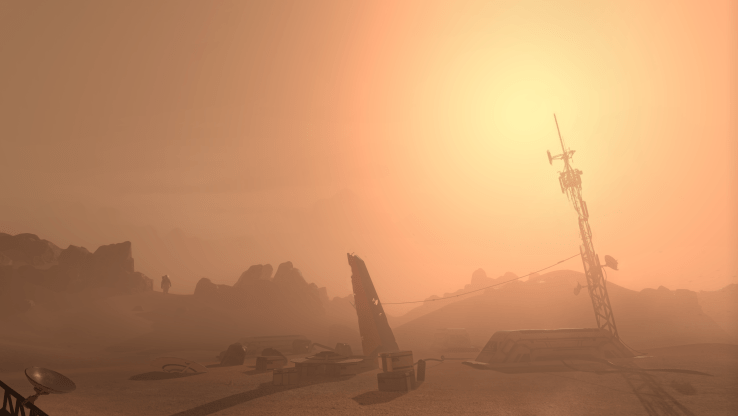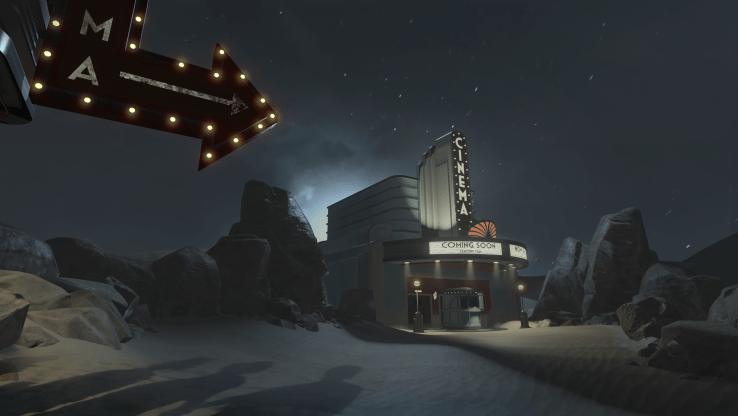Nobody understands community and online social dynamics quite like Linden Lab, the SF-based team that has maintained a very odd, somewhat dysfunctional digital society called Second Life for what’s coming up on thirteen years.
The team is now embarking on its most ambitious project yet, a wide-reaching virtual reality network called Project Sansar that is, in many ways, aiming to become a new layer of reality that gives individuals and businesses a space to experiment with VR environments for their first time.
I had the chance to sit down for a demo of Sansar with Linden Lab CEO Ebbe Altberg this past week and take an early look into some of the platform’s first environments.
Traversing the worlds of Sansar and chatting with my guide, Linden Lab VP of Product Bjorn Laurin, was a mostly seamless experience but still an oddly unsettling one. It’s not that anything was particularly creepy about the place I was viewing through an Oculus Rift headset. Sansar is visually placid and often beautiful, but it’s also startlingly scalable and boundless. Scale is something that’s often taken for granted in an age of video game epics like Skyrim and GTAV, but when every horizon you see through your own point-of-view is conquerable, you’re left to either feel very bold or very lost.

Linden Lab is hoping creators feel empowered by the platform to build worlds that solve problems and create opportunities for social interaction. The company is currently taking applications for 3D content builders to take part in a Project Sansar Creator Preview.
Project Sansar is designed to allow every average Joe to create their own VR-facing presence or space on the platform as easily and non-technically as they desire. Linden Lab is hoping to monetize their VR world by building what is essentially an app store for VR creative properties. That could mean a small business buying a trade show template someone else designed so that they can host a digital get-together in Sansar, or it could mean a university purchasing a classroom or lab model to build their own VR presence and teach students in more immersive ways.
It’s almost trivial to think of more specific examples because in many ways Sansar is trying to crack the base question of what physical presence means to communication and whether additional benefits can be yielded from a VR environment when it’s replicated to a T while implementing actions and mechanics that aren’t possible on earth.

At a certain point, when their guards are down, companies in the VR space seem to subtly allude to the fact that they’re expecting virtual reality to swell up to replace a pretty significant percentage of our active lives rather than just enhance it.
There were plenty of concerns at the beginning of this millennium that video games like Second Life were ushering in a godless digital era that would soon see people strapping computers to their faces and foregoing real reality entirely. Sansar is not quite OASIS, the all-encompassing fictional VR world detailed in the novel Ready Player One, but it is looking to evolve in a similar pattern.
Sansar perhaps has more challenges ahead of it than any VR platform I’ve interacted with, but that’s largely because it’s just so frighteningly ambitious. Like Second Life, Project Sansar is not an experience that needs to be perfect at its initial launch or see a certain number of first week user numbers to be a hit. It just has to stay consistent, evolve with the hardware/interface trends of modern VR and steadily push boundaries as it updates.
Linden Lab is a uniquely bizarre company that is still thriving off the successes of a product that was introduced when people were grabbing AOL disks to connect to the web. In the decade since the greater public stopped caring about Second Life, nearly a million people have continued logging in and checking on their digital lives, running digital businesses, making digital friends and digitally living out their odd sexual fetishes.
During this past 13 years, Facebook and the social media revolution have taken off and taken hold, powerful smartphones found their way into a few billion people’s pockets and the way we all interact online has grown richer and more engrossing. Yet all those people keep logging in to take stock of their virtual lives because regardless of how much the theoretical polygon counts on the latest systems increase, the hardest thing to replicate online will always be a sense of community.
This area will be where Sansar faces its greatest test, building a digital community for a new generation of internet users on a medium that’s not yet fully understood. The early beta shows great promise and while a wide release of its desktop and VR versions is still likely months away, it’s clear that Linden Lab understands the daunting magnitude of both Project Sansar’s challenges and its potential.
